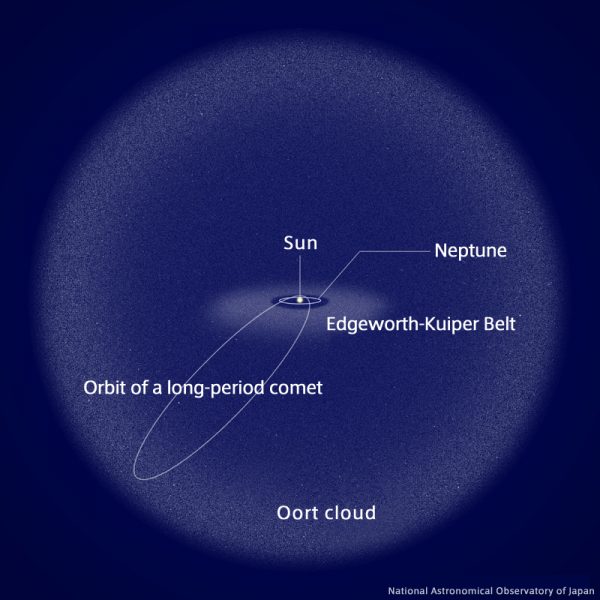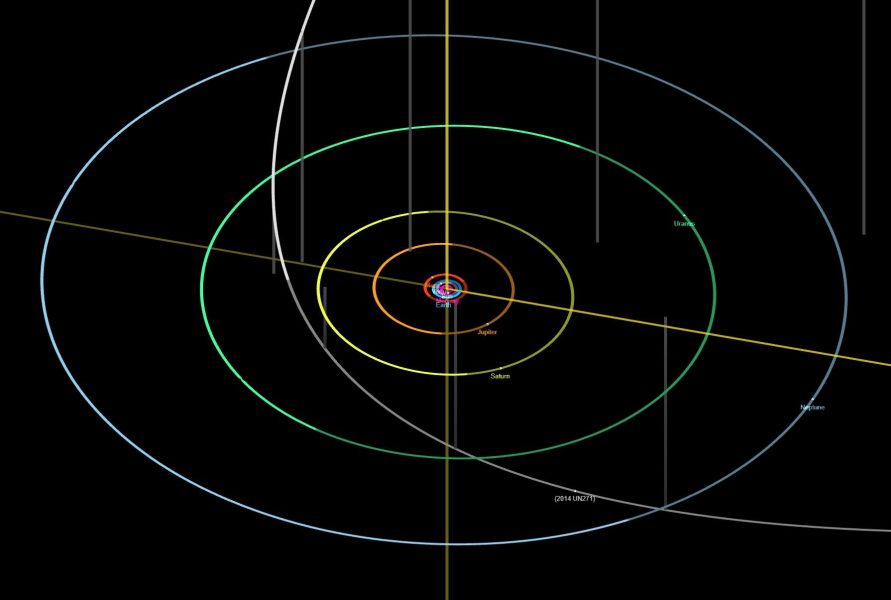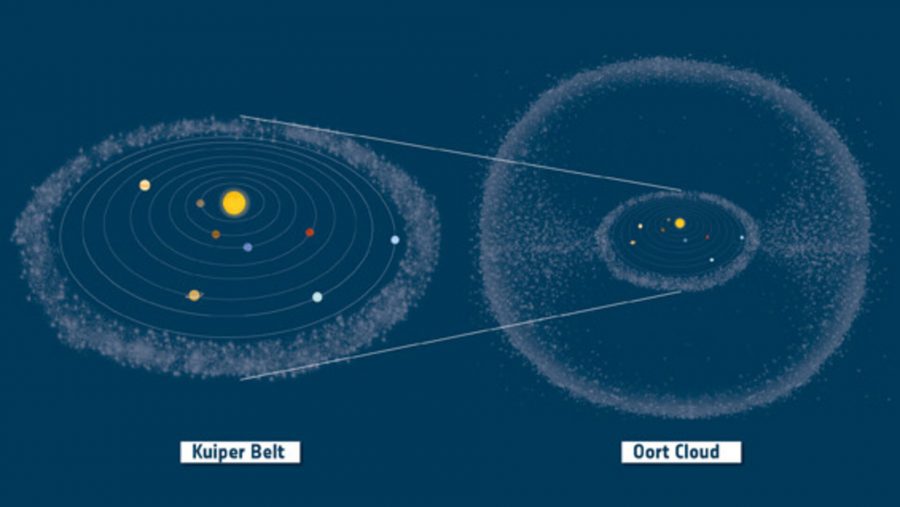Updates:
The Minor Planet Center has now officially designated this object a comet: Comet Bernardinelli-Bernstein (C/2014 UN271).
Astronomers have spotted the largest comet ever recorded coming from the Oort Cloud. And at 20 times the distance between Earth and the Sun (20 astronomical units), beyond Uranus’s orbit, it’s already venting gas.

NAOJ
New observations, taken on June 22nd with the 0.51-meter SkyGems Remote Telescope in Namibia, reveal “clear cometary activity, with a 15-arcsecond coma,” Luca Buzzi reported this morning on the Minor Planet Mailing List.
A Big Comet
Astronomers discovered the comet, dubbed 2014 UN271, in data collected by the Dark Energy Survey, which recently released data on hundreds of millions of galaxies spread over one-eighth of the sky. Survey computers spent millions of hours automatically searching the entire data set for transient objects moving across the sky. And from 2014 to 2018 one of them was the comet, yielding the orbit reported June 19th in a Minor Planet Electronic Circular.
The orbit immediately drew attention because it showed the comet coming from deep in the Oort Cloud, a group of planetesimals surrounding the Sun at icy distances of about 1,000 to 100,000 a.u. The comet will continue inward almost to the orbit of Saturn before heading back out again. The new observations put it at about magnitude 20, which enables a rough estimate of its diameter of 160 kilometers (100 miles). That puts it at the large end of objects seen from the Oort Cloud, seen as long-period comets by the time they’re visible from Earth. But it’s a lightweight relative to the rest of the solar system, so it could be tossed around by a close encounter with a planet.
That size isn't enough to make it a dwarf planet, but it is the biggest object from the Oort Cloud that we’ve seen so far. It’s ahead of the modern record-holder, Comet Hale-Bopp (C/1995 O1), which was only about 60 kilometers across. The Comet of 1729 (C/1729 P1), may have spanned on the order of 100 km; however, it never came much inside Jupiter's orbit, so observers at the time were limited in what they could see.
The Orbit

NASA
“The orbit we've got [for 2014 UN271] is actually quite good,” says Bill Gray of Project Pluto. It's based on 32 observations taken over four years with a 4-meter telescope and the Dark Energy Survey’s DECam high-performance camera. From that data, calculations predict that the comet will reach perihelion on January 23, 2031, at 10.95 a.u., just outside the most distant point of Saturn's orbit. Tony Dunn's Orbit Simulator site shows it approaching at an inclination of 95°.
Aphelion, or the farthest point from the Sun, is much more uncertain because the orbit is extremely elongated and the swing around Saturn will alter its orbit, but Gray says the comet will clearly turn around in the Oort Cloud, and it’s definitely not an interstellar object. When the MPEC orbit was updated with Buzzi’s new observations, the comet's most recent aphelion was calculated to be 40,000 a.u. and the prediction for the next one became 55,000 a.u. That means the comet took 1.39 million years to reach its present position from the last aphelion, and will take about 2.2 million years going back to the outer edge of its modified orbit, says amateur astronomer Sam Deen.

ESA
Gray sees little likelihood of pre-discovery observations because the comet was a little fainter than magnitude 22 when first spotted, and earlier it would have been even fainter. On the other hand, he says, it’s possible the comet will show up in observations taken since 2018.
New, targeted observations will help constrain the comet’s orbit as well as other key characteristics, including its rotation period, satellites, and composition. The behavior of comets is notoriously difficult to predict, but this one is getting off to a very early start, and many more telescopes will be turned toward it in the coming months and years.
 8
8









Comments
Andrew James
June 23, 2021 at 4:13 am
Umm... " From that data, calculations predict that the comet will reach perihelion on January 23, 2031, at 10.95 a.u...most recent aphelion was calculated to be 39,740 a.u. and the prediction for the next one became 54,700 a.u." What are the errors here? As e=0.9984815 and n=0.00000161 only, 40,000 and 55,000 AU portrays closer to the truth.
You must be logged in to post a comment.
Monica Young
June 23, 2021 at 12:43 pm
I've updated this with correct sig figs 🙂
You must be logged in to post a comment.
Rod
June 23, 2021 at 7:51 am
The orbit and period is apparently difficult to nail down. Note this report, Space object with orbit stretching into the Oort cloud discovered, https://phys.org/news/2021-06-space-orbit-oort-cloud.html The period is said to be 612,190 years. "One trip around the sun has been calculated to take 612,190 years. It is currently moving deeper into the solar system, which means astronomers will have an opportunity to observe it 10 years from now." My observation. Wikipedia reports on this object. https://en.wikipedia.org/wiki/2014_UN271 Wikipedia reports aphelion distance 40,000 au inbound, 55,000 au outbound. Perihelion distance 10.95 au. Semi-major axis inbound = 20,000 au, outbound = 27,000 au, e = 0.99945 inbound, 0.9996 outbound. Orbital period or P = 3 million years inbound, 4.5 million years outbound. Apparent magnitude mv + 21.2. Compare the orbital period in wikipedia to the phys.org report, 612,190 years. Using Jean Meeus Astronomical Alogrithms, I used a = 24,000 au, e = 0.9996, aphelion = 47,990 au, perihelion = 9.6 au, mass of object = 6 x 10^17 g cm^-3. Orbital period = 3.7183 x 10^6 years and in a period of 1 billion years could complete 269 revolutions around the Sun, using 612,190 year period, even more perihelion passages are needed.
Whether the comet/object has completed multiple perihelion passages or aphelion passages is another story.
You must be logged in to post a comment.
Andrew James
June 23, 2021 at 9:51 pm
Exactly. Perturbations alone make the analogous to a steel ball in a pinball machine. Predictions are a nightmare when orbits are influenced by multiple masses and the body is moving so slowly. e.g. When at aphelion at 55,000 AU, even the nearby stars are significant enough to greatly change the orbital parameters elements. How 612,190 years could be predicted is silly when the error is at least ±50,000 years - so it is better stating just 600,000 years. The next passage becomes very difficult to adjudge, if at all.
Celestial mechanics is often considered as highly precise, which writers often overreach when object masses are influenced by multiple sources. [The three body problem alone reinforces this view.] It is too easy to be fooled, when you see the calculations out to +12 decimal places in the JPL Small-Body Database Browser! Clearly the ephemeris is good enough for ±100 years at best. Your assessment of these contradictions are valid. Thanks.
You must be logged in to post a comment.
Morbius
June 24, 2021 at 11:34 am
It appears to me that this is an excellent opportunity for a mission to land a probe on this comet that could ride along with it for decade's as it returns to the Oort cloud gathering valuable data and making observations not possible in any other way at this time. Regardless of cost, this could have a major payback in scientific knowledge.
You must be logged in to post a comment.
goodricke1
June 25, 2021 at 4:32 pm
Why are they calling it Bern^2 or am I showing my ignorance there...?
You must be logged in to post a comment.
BobMcNaught
June 25, 2021 at 6:01 pm
I love the notion of comet satellites.
Wish this thing was coming real sun-grazing close!
You must be logged in to post a comment.
Yaron Sheffer
June 30, 2021 at 5:03 pm
Amazing visitor. And many, many more awaiting discovery way out there. Here is a fun fact: it will go as far as 55,000 astronomical units (AUs) into the Oort cloud, whereas there are 63,000 AUs in one light year. That aphelion is 0.87 of a light year away...
You must be logged in to post a comment.
You must be logged in to post a comment.